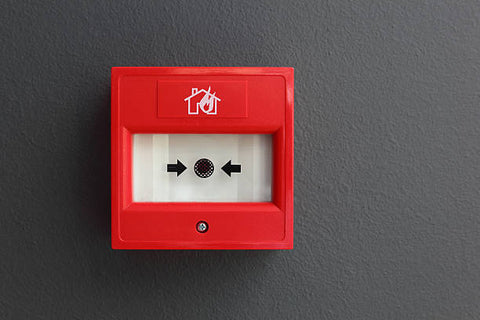FPLP vs. FPLR: Which Fire Alarm Cable To Choose?

Fire alarm cables should be chosen right as they guard the fire safety of the buildings. This blog discussed common types of fire alarm wire: FPL, FPLR, and FPLP, their specifications, regulations, and applications.
What is a fire alarm cable?
A fire alarm cable is a low-voltage cable used specifically for fire alarm signal transmission. These are the multiconductor cables with two or more copper conductors and thermoplastic insulation designed to withstand the impact of heat. Naturally, fire alarm cables are designed to be flame-retardant as they are exposed to the probability of fire hazards during their daily applications. They are used in fire protective signal circuits. The cables are coated in a bright red PVC jacket to highlight their purpose. The regulations that apply to fire alarm wires in the USA are NEC, UL, and NFPA. Additionally, the cables comply with ETL and RoHS.
General Specifications and Applications Of Fire Alarm Cables
The sizes of fire alarm cables vary between 12 AWG and 18 AWG, depending on the application. The final size choice depends on the expected voltage drop and the electric circuit characteristics.
Fire alarm and security systems that employ fire alarm cables include detectors of smoke, smoke alarms, security communications systems, microprocessors, pull boxes, fire alarms, various control circuits, and burglar alarms, among others. These are precise low-voltage systems that are highly likely to be influenced by fire or smoke. Fire alarm systems can be located in buildings, outdoors, or underground.
The conductors of fire alarm cables can be solid or stranded. While choosing solid or stranded conductors matter for many types of cables, there is usually no substantial difference in fire alarm wiring. Solid conductors are generally more common than stranded ones. The cables can have up to 6 conductors, with two or three conductors being the most common. The number of conductors usually depends on the mechanics of a device used in the security system.
Fire alarm cables are always used in fire alarms with no alternatives, as these are the only cables that are specifically rated for the purpose. While many types of low-voltage wire are interchangeable when it comes to applications, this is not the case with fire alarm wires. Common types of fire alarm wires are FPL, FPLR, and FPLP. Let's dive into the meanings behind those acronyms and some other ones.
Types of Fire Alarm Cables Explained: FPL, FPLR, FPLP, and Others
The most common types of fire alarm wires are rated for power-limiting circuits:
FPL is a general-purpose power-limited fire alarm cable. This means that it is not rated plenum or riser. The cable cannot be used in plenum spaces, air ducts, risers, and other spaces with specifics related to the airflow. Despite this, FPL passes many required fire-resistance tests, such as UL 1424 and UL 1581. FPL cable is not shielded.
FPLR is a riser-rated power-limited FA cable meant for riser applications placed vertically throughout the floors of the building. These include shafts of the elevators. FPLR are flame-retardant in a specific way, as they prevent the fire from spreading vertically in addition to the general fire prevention FPL is known for. FPLR cables are expected to self-extinguish if the fire occurs and produce less smoke when exposed to fire. FPLR comes in shielded and non-shielded variations. In addition to the general UL 1424 test, this cable follows UL 1666 for vertical risers.
FPLP is a plenum-rated power-limited fire alarm cable used in the plenum-rated spaces of the building. A definition of plenum is any air-tight space on the building, including heating, ventilation, and air conditioning HVAC buildings. FPLP has higher fire-resistance than FPLR due to the specific nature of plenum spaces. These cables are also expected to self-extinguish in the event of a fire, just like FPLR. Moreover, they are also designed to produce as minimum smoke as possible. FPLP can be either shielded or unshielded. It passes UL 1424 and tunnel test UL 910 for plenum-rated cables.
Some manufacturers will combine FPL and FPLR into one category, simply called non-plenum cable.
Non-Power Limiting Fire Alarm Cables
Aside from the most popular fire alarm cables mentioned above, there are also cables for non-power limiting circuits. These circuits are described in a different part of the National Electric Code than power-limiting ones (760-21 and 760-23 for non-power limited vs. 760-41 for power-limited ones).
Non-power-limited fire circuits have no limits on line voltage and can operate up to 600 volts. They are supposed to limit the spread of fire. However, they are rare in modern buildings, which means that non-power limited fire alarm cables are used less often. These cables are general-purpose NPLF and plenum-rated NPLFP. Riser-rated NP fire alarm cables are not a thing.
Direct Burial Fire Alarm Cables
For direct burial applications, a fire alarm cable should have a specific direct burial rating. Any subtype of FA cable can be rated for direct burial, including FPL, FPLR, and FPLP. Fire alarm wire can also be buried in PVC pipes. Direct burial fire alarm cables are also the ones recommended for non-buried outdoor use.
Note on Shielded vs. Unshielded Fire Alarm Cables
FPLR and FPLP both can come with or without shielding. For both of them, the shielding is typically aluminum polyester foil shield. The answer to the question of whether to use shielding is pretty simple - you should go for shielding in case there is a risk of electromagnetic interference.


















